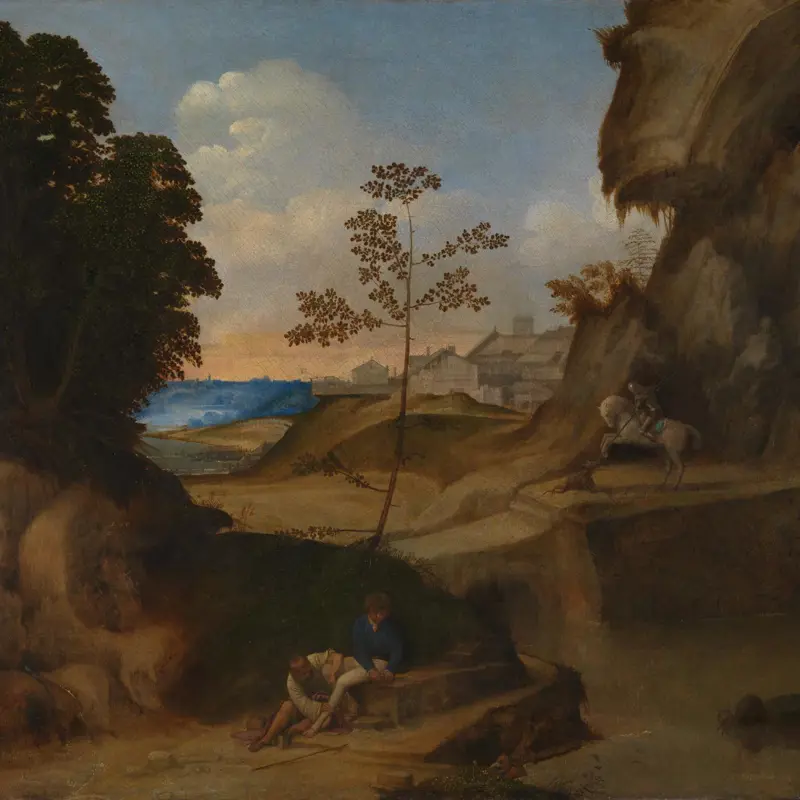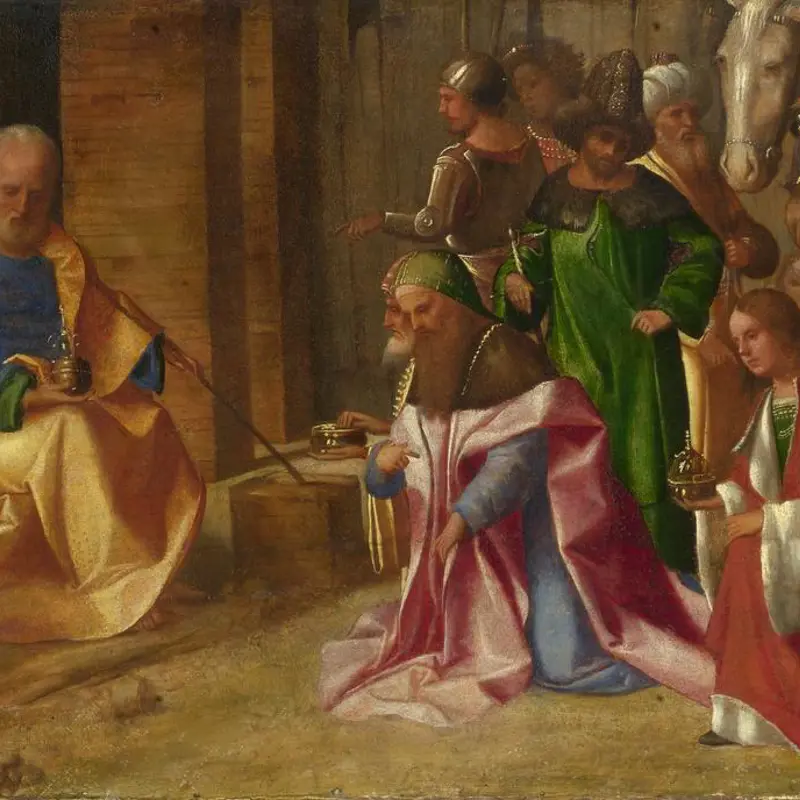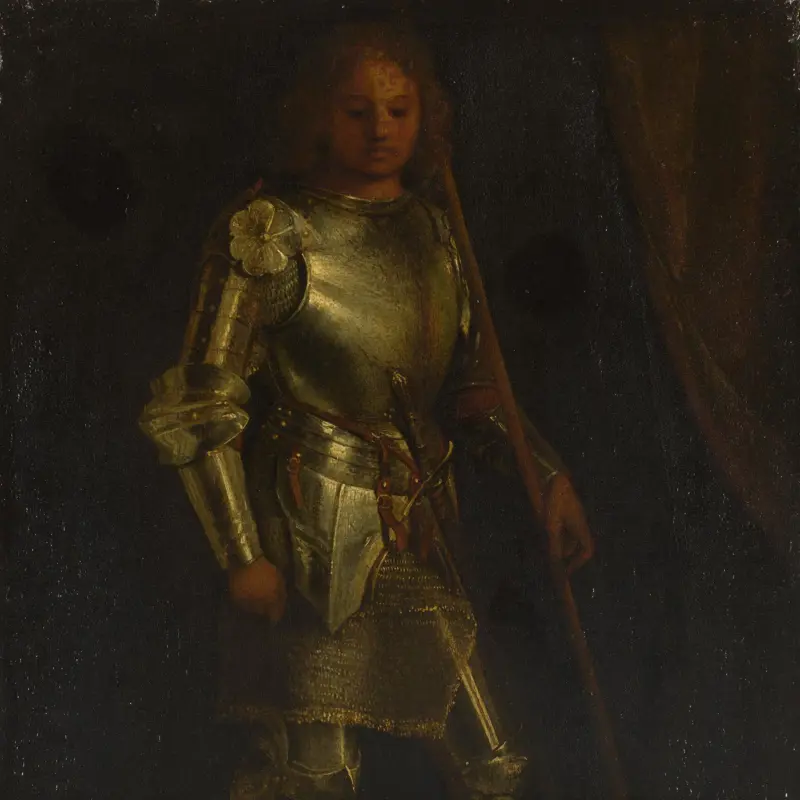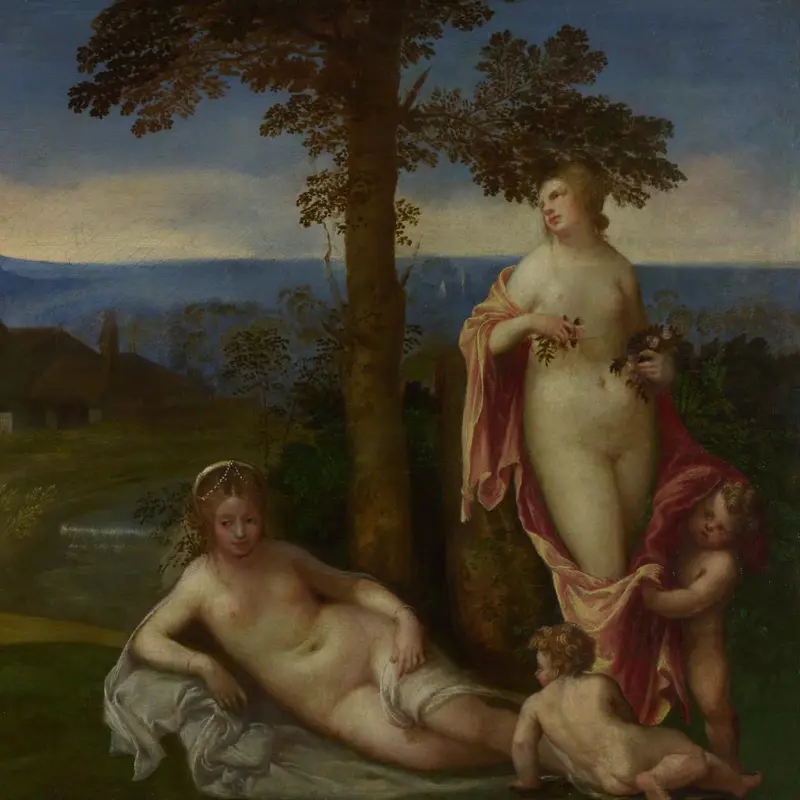Follower of Giorgione, 'Homage to a Poet', early 16th century
About the work
Overview
The subject of this painting is obscure – a melancholy enthroned figure sits with books at his feet. A young man sitting on the step plays a lute as a boy approaches the throne and a kneeling man offers a bowl of flowers. All have respectfully removed their hats. A hermit appears in a cave in the rock face to the left.
It has recently been suggested that the subject is Saturn exiled by Zeus; another theory is that it may represent Joseph and Pharaoh’s dream. The leopard licking his paw is also included in the Orpheus of about 1515 by Giovanni Bellini (National Gallery of Art, Washington).
It is unclear whether this is a work by Giorgione himself or by one of his followers. It was likely painted by the same artist as the Judgment of Solomon and Moses and the Proof by Fire, usually given to Giorgione (both Uffizi, Florence). It is probably the painting described in the 1603 inventory of the collection of Cardinal Pietro Aldobrandini in Rome.
Key facts
Details
- Full title
- Homage to a Poet
- Artist
- Follower of Giorgione
- Artist dates
- 1473/4? – 1510
- Date made
- early 16th century
- Medium and support
- oil on wood
- Dimensions
- 59.7 × 48.9 cm
- Acquisition credit
- Bought, 1885
- Inventory number
- NG1173
- Location
- Not on display
- Collection
- Main Collection
- Frame
- 19th-century English Frame
Provenance
Probably identifiable with a picture listed in inventories of the Aldobrandini collection in the seventeenth century. In the 1603 inventory of Cardinal Pietro Aldobrandini’s collection the latter appears as:
Un quadro con un poeta coronato di lauro con tre altre figure attorno con una tigre, et un pavone, di mano di Raffaelle da Urbino.
Similar wording, but with the additional information that the picture was on panel and the height 2½ palmi was given in another (undated) inventory (before 1665). Probably no. 15 (‘Giorgione—King David instructing a pious man in his devotions’—‘from the Aldobrandini Villa’) in the catalogue printed by Buchanan of pictures exhibited for sale by Alexander Day in 1800–1. No. 9— ‘Solomon instructing Youth by Giorgione’—in the exhibition of pictures belonging to Alexander Day, Egyptian Hall, London, before 1833, where stated to be from the ‘Aldobrandini Cabinet at Rome’. No. 21 (under the same description) in the Day sale, Christie’s, 21st June, 1833, where bought White. No. 301 (as Raphael) in Edward White sale, Christie’s, 6th April, 1872, where bought H. B(ohn). No. 113, H. Bohn sale, Christie’s, 19th March, 1885, where bought Lesser for the Gallery.
Additional information
Text extracted from the ‘Provenance’ section of the catalogue entry in Cecil Gould, ‘National Gallery Catalogues: The Sixteenth Century Italian Schools’, London 1987; for further information, see the full catalogue entry.
Exhibition history
-
2009GiorgioneMuseo Casa di Giorgione12 December 2009 - 11 April 2010
-
2012Titian's First Masterpiece: The Flight Into EgyptThe National Gallery (London)4 April 2012 - 19 August 2012
-
2012Il Tiziano mai visto: La fuga in Egitto e la grande pittura venetaGallerie dell'Accademia (Venice)29 August 2012 - 9 December 2012
-
2015Venetian Visions: Selections from the National Gallery, LondonMaier Museum of Art at Randolph College6 November 2015 - 31 March 2016
-
2017Heart Labyrinths. The "two friends" by Giorgione and the seasons of feeling in the Italian art of the sixteenth century.Museo Nazionale di Palazzo Venezia22 June 2017 - 17 September 2017
Bibliography
-
1959Gould, Cecil, National Gallery Catalogues: The Sixteenth Century Venetian School, London 1959
-
1987Gould, Cecil, National Gallery Catalogues: The Sixteenth Century Italian Schools, London 1987
-
2001
C. Baker and T. Henry, The National Gallery: Complete Illustrated Catalogue, London 2001
About this record
If you know more about this work or have spotted an error, please contact us. Please note that exhibition histories are listed from 2009 onwards. Bibliographies may not be complete; more comprehensive information is available in the National Gallery Library.




